- Home
- David McCullough
The American Spirit Page 9
The American Spirit Read online
Page 9
France is truly hallowed ground for Americans, let us always remember. Of the American dead from both wars more than 60,000 are buried in French soil, at Meuse-Argonne, Normandy, and four other cemeteries. At Meuse-Argonne, the largest, lie fully 41, 246 American dead.
Charles de Gaulle and Dwight Eisenhower, Paris, 1944
It was also in France—in Paris close by the Place de la Concorde—that headquarters for the Marshall Plan was established in 1950.
Much of this is familiar history, I know. But some things bear repeating. As Samuel Johnson wrote, we “more frequently require to be reminded than informed.” Besides, there is far more to history than wars and foreign affairs, and that, too, must be taken into account in any fair appreciation of the ties that bind America and France.
The love of Paris by talented, aspiring young Americans, its large importance as a place of inspiration and creative freedom, dates from our very beginnings as a country. Time and again Paris changed their lives and thus hugely influenced American art, American literature, music, dance, and yes, American science, technology, and medicine.
It was in Paris in 1784, in the library of Jefferson’s mansion on the Champs-Élysées, that Jefferson and the young American artist John Trumbull blocked out on a small sheet of paper the idea for Trumbull’s famous portrayal of the signing of the Declaration of Independence, the painting which, over time, has been seen by more people than any ever done by an American. And it was there in Paris that Trumbull, ambitious to make a mark and encouraged by Jefferson, embarked on the series of historic portraits and paintings of the Revolution that were to be his great life works.
John Singleton Copley, another of the eighteenth-century American masters, wrote of “something in the air” in Paris that quickened creative vitality. James McNeill Whistler, who arrived in Paris in the 1850s, unknown, penniless, and precocious, would all but reinvent himself there. Mary Cassatt from Philadelphia, settling in Paris in 1877, felt she could at long last work with total independence. “I began to live,” she wrote.
Paris was the capital of the art world, the Louvre, its Pantheon, and the legion of aspiring Americans who flocked to the city to paint, sculpt, study, to live the vie de bohème reads like a Who’s Who of American Art—Trumbull, Copley, Samuel F. B. Morse, Whistler, Mary Cassatt, John Singer Sargent, Winslow Homer, Thomas Eakins, Henry Tanner, Augustus Saint-Gaudens, Childe Hassam, to name only a few.
Samuel F. B. Morse spent the better part of his time in Paris, during the early 1830s, painting a huge interior view of the grand gallery at the Louvre. Earlier, while Lafayette was in New York, Morse had been chosen to do the French hero’s portrait, a dramatic, life-size painting that hangs still in New York’s City Hall. It was later, on his voyage home, inspired by something he’d seen in France, that Morse conceived the fundamental idea for the telegraph.
John Singer Sargent was an immediate triumph. His Madame X, the portrait of Madame Pierre Gautreau that caused a sensation in Paris, was done when Sargent was all of twenty-eight.
Inspired by French Impressionists, Americans by the dozens became Impressionists. Childe Hassam learned to paint as readily with the fluid brushwork of the French Impressionists April showers on the Champs-Élysées as he would an October morning on Beacon Street, Boston, or Fifth Avenue with all flags flying on Allies Day, 1917.
Those artists who didn’t get to Paris wished they could. And the pull for writers was no less. Some of the greatest landmarks in American literature—works as thoroughly American as any we have—were, in fact, written under the spell of Paris, “the light of Paris . . . the far spreading presence of Paris,” as Henry James wrote.
I have fallen in love with American names,
The sharp names that never get flat,
The snake-skin title of mining claims,
The plumed war-bonnet of Medicine Hat,
Tucson and Deadwood and Lost Mule Flat.
These, the wonderful opening lines of Stephen Vincent Benét’s poem “American Names,” were composed not, as one might assume, somewhere west of the Brazos, but in Paris. And so, too, was Benét’s great narrative poem of the Civil War, John Brown’s Body.
Ralph Waldo Emerson, recalling his own time in Paris, a generation earlier, had observed, “We go to Europe to be Americanized.”
No less an American classic than James Fenimore Cooper’s The Prairie was written during the seven years Cooper made Paris his home. Ethan Frome—Ethan Frome of all books!—was written in the library of Edith Wharton’s sumptuous apartment on the rue de Varenne in 1911, in the heyday of the Belle Époque or about as far removed from the bleak New England setting of her classic novel as one could imagine. In fact, her story had its origins in French, as an exercise done for her French teacher in Paris.
In the New York society of her childhood, as Edith Wharton recounts in her autobiography, the arts were a world apart. Her mother and father considered authorship in particular as “something between a black art and common labor,” and certainly not for her. In Paris, as nowhere else, she wrote, her work became “the core” of her life. With the outbreak of World War I, she was one of the first American women to volunteer in the French war effort, collecting clothing, food, and medical supplies. By the time the war was over, 25,000 American women served in France, a point of history too little known or appreciated on both sides of the Atlantic. Among those men and women who came home from the war were a substantial, though unknowable, number whose outlook was no longer the same, as expressed by the popular song of the day: “How Ya Gonna Keep ’Em Down on the Farm After They’ve Seen Paree?”
In the decades after the war, an estimated 35,000 Americans took up life in Paris. It was the place to be, and especially for the young, the gifted, and aspiring. “I arrived fresh out of Brooklyn, twenty, and all agog,” remembered Aaron Copland.
Gertrude Stein and Ernest Hemingway, the two outstanding self-promoters of the day, made famous “their” Paris of the 1920s, but, of course, there were hundreds of others writing, painting, composing music, experimenting with modern dance, or just soaking up the expatriate life. You know them: William Faulkner, F. Scott Fitzgerald, Grant Wood, Edward Hopper, Richard Wright, Langston Hughes, Sherwood Anderson, Stephen Vincent Benét, Carson McCullers, Hart Crane, Cole Porter, George Gershwin, Isadora Duncan, Josephine Baker. Like their counterparts of an earlier time, they found a kind of spiritual home in France and among the French. Especially for creative, independent-minded American women and for African Americans like Richard Wright, Langston Hughes, and Josephine Baker, there was freedom of a kind, an acceptance, such as they had not known in their own country.
Langston Hughes
It’s a matter of no small importance that in the era before World War I, the two outstanding American women in art and literature—two who hold an enduring place in the forefront among all American painters and writers—Mary Cassatt and Edith Wharton, could only find themselves and thrive in their work as they did far from America, in Paris, and yet they never considered themselves as anything other than Americans. Mary Cassatt lived out her long life in Paris and is buried there. Edith Wharton, too, except for summers in Massachusetts, made Paris her home and is buried there, as are Isadora Duncan and Josephine Baker. The funeral service for dancer Josephine Baker at the Church of the Madeleine in 1975 was the grandest Paris funeral ever seen for an American.
Cole Porter, back from years in France, set his last two Broadway musicals, Can-Can and Silk Stockings, in Paris. He was old and ill when he wrote the song “I Love Paris,” but as William Zinsser has said, it “still sounds young and enamored of the city in every season and every kind of weather, from drizzle to sizzle.”
It was in the antique shops of Paris that George Gershwin found the taxi horns with exactly the sound he needed for his American in Paris suite. Years after Gershwin’s death, the 1951 movie An American in Paris, with an all-Gershwin score and starring Gene Kelly, became a tremendous hit and won six Oscars, including Best Pi
cture. An enduring classic, it gave millions of Americans a feeling for Paris they would never quite lose.
George Gershwin
(I must tell you that as an impressionable eighteen-year-old college freshman from Pittsburgh who was head over heels in love at the time and dreaming of becoming an artist, to see Gene Kelly—who came from Pittsburgh—up there on the big screen unabashedly in love, dancing, singing, and painting his way through Paris to his heart’s delight . . . Well, that was something!)
John Adams and Thomas Jefferson are both on record that after their own country, they would have chosen first to live in France. But as an example of a skeptical, disapproving American changing her tune, none surpasses Abigail Adams, who at first found almost nothing to like about Paris or the French. The dirt, the morals, the extravagances and frivolities were by her starch Yankee standards perfectly deplorable. Yet in less than a year, when it came time to go, she hated to leave. She spoke no French, as her husband and her son John Quincy did. That hardly mattered. She had been completely won over. She loved the opera, the theater, the acceptance of women in polite circles as the social and intellectual equals of men. In young Madame de Lafayette she had found one of the warmest friendships of her lifetime. Adrienne de Lafayette was still in her twenties. She spoke English and despite her wealth and position, dressed simply and disliked pretentious display quite as much as did Abigail Adams. She was, as well, like Abigail, openly devoted to her husband and children.
At the Massachusetts Historical Society in Boston are the letters of John and Abigail Adams dating from their time in Paris, as well as Jefferson’s Paris love letters to the English artist Maria Cosway, and the original manuscript of the only book Jefferson ever wrote, his Notes on the State of Virginia, which was first published in France. And there, too, are letters from Paris by Dr. John Collins Warren, the Boston surgeon who famously demonstrated ether anesthesia for the first time, these written in the early nineteenth century when Paris was considered the leading center for medical studies and advanced medical practice, and Dr. Warren was an intensely serious student there. Oliver Wendell Holmes, Sr., is another who studied medicine in Paris, and his letters, written in the 1830s, are among the most engaging we have. Dr. Holmes, famous as the author of The Autocrat of the Breakfast-Table, taught anatomy at Harvard for thirty-five years, his influence reaching far.
But think, too, of the famous landmarks and monuments here in America that we consider so very American, so emblematic of American greatness, American freedoms, enterprise, or ingenuity, and that are, in fact, French in part or whole. Our capital city on the Potomac was laid out by the French architect and engineer Major Pierre L’Enfant. The magnificent life-size statue of George Washington at the state capitol of Virginia in Richmond—the great prototype for nearly every American sculpture of Washington—is the work of the French master Jean-Antoine Houdon. Jefferson’s Monticello, with its picturesque dome, is a French house in spirit and in detail, inspired by a Paris landmark, the Hôtel de Salm, a building Jefferson adored and that still stands beside the Seine.
The Louisiana Purchase pretty much fell into our lap when Napoleon offered it to Jefferson at a bargain price. Yet, the fact remains that the geographic reach of the United States of America thus more than doubled with the acquisition of land that had belonged to France.
And certainly at a gathering such as this we should not forget the master work of the French historian Alexis de Tocqueville, Democracy in America. Published in 1835, it remains one of the wisest books ever written about us.
The Brooklyn Bridge owes the very legs it stands on to the pioneering work of French civil engineers. (Its ingenious underwater foundations were worked out by Washington Roebling from studies he made in France of “caissons” first developed by the French.) And it was the brilliant French engineer Baron Godin de Lépinay who saw as no one did, the only way to succeed with a ship canal across Panama. His plan, presented at an international conference on the Left Bank in Paris in 1879, and roundly ridiculed by French and American engineers alike, is the Panama Canal of today, our “American triumph.”
Then, to be sure, there is our surpassing gift from France, Miss Liberty herself, holding high the beacon of freedom in New York Harbor. No other country ever honored another with a gift of such magnitude or everlasting popularity.
And think of all the places on the map of America besides Louisiana and New Orleans and Baton Rouge—the cities, states, small towns, lakes, and rivers—that have names that are entirely French, however badly we pronounce them: Des Moines, Lake Champlain, St. Louis, Sault Ste. Marie, Terre Haute, Vermont. And all those American colleges and universities called Duquesne, Marquette, Notre Dame, and, yes indeed, Lafayette.
Statue of Liberty torch
We Americans love French fashions, French lace, French doors, French dressing. We’ve made French fries a national staple. We celebrate all out with French champagne, gussy up with French perfume and French cuffs, and call it “puttin’ on the Ritz”—as at the Ritz in Paris, that is. On evenings like this, if the speaker runs on too long, you are perfectly within your rights to consider French leave.
For all our love of French wine, and as dearly as we pay for the pleasure, it represents a mere 3 percent of all that we import from France. What we buy most from France are machinery, construction materials, and airplanes. Further, the United States has become the largest investor in France. France is the travel destination of choice for two million Americans a year, and once there we stay longer than anyone. Meanwhile some 1,300,000 of our students are taking French, making it, after Spanish, the second most commonly studied foreign language.
When considering Americans of French descent worth noting, we might start with Paul Revere. In all, eleven million of us claim French or French Canadian descent.
The one serious breach with France in our early years as a nation was the undeclared war at sea during the presidency of John Adams. And extremely serious it was. Then, during negotiations to resolve the crisis, came the odorous XYZ Affair. It very nearly turned into a full-scale war with Napoleon, but to the everlasting credit of John Adams and his chief emissary to France, John Marshall, an honorable settlement was reached. For Adams it was the proudest, most beneficial accomplishment of his presidency. As he would tell a friend, “I desire no other inscription over my gravestone than: ‘Here lies John Adams, who took upon himself the responsibility of peace with France in the year 1800.’ ”
Adams lived to see Lafayette’s return in 1824 and there was a moving reunion of the two old patriots, when Lafayette paid a call at Quincy.
As a gesture of national gratitude Congress awarded Lafayette, who was deeply in debt, a cash grant of $250,000, an absolute fortune and approximately what he had earlier contributed from his own funds to help the cause of the American Revolution. The day of Lafayette’s departure from Washington, in 1825, after a long visit at the White House, the new president, John Quincy Adams, his voice trembling, spoke for all the American people. Here is what he said:
We shall look upon you always as belonging to us, during the whole of a life, as belonging to our children after us. You are ours by more than patriotic self-devotion with which you flew to the aid of our fathers at the crisis of our fate, ours by that unshaken gratitude for your services which is a precious portion of our inheritance, ours by that tie of love, stronger than death, which has linked your name for endless ages of time with the name Washington. . . . Speaking in the name of the whole people of the United States and at a loss only for language to give utterance to that feeling of attachment with which the heart of the nation beats as the heart of one man—I bid you a reluctant and affectionate farewell.
On this occasion, gathered as we are here to honor Lafayette in our way, let us wish wholeheartedly that the ties that bind America and France, and the tradition of respect and affection between our countries, will continue with renewed spirit.
The Love of Learning
BOSTON COLLEGE
<
br /> Boston, Massachusetts
2008
We haven’t a lot of ceremony left in American life, alas, but commencements do go on, year after year, and in the grand tradition, with full, appropriate panoply, bringing together, as we see here today, people from all walks of life, all parts of the country, and indeed of the world, to pay tribute to genuinely worthy accomplishment. The importance of education has been a prevailing theme in American life from the beginning and may it ever be so.
Information. Information at our fingertips. Information without end . . .
The Library of Congress has 650 miles of shelves and books in 470 languages . . . Napoleon was afraid of cats . . . A porcupine is born with 30,000 quills . . . A mosquito beats its wings 600 times per second . . . Coal production in the United States is second only to that of China . . .
It’s said ad infinitum: Ours is the Information Age. There’s never been anything like it since the dawn of creation. We glory in the Information Highway as other eras gloried in railroads. Information for all! Information night and day!
. . . A column of air a mile square, starting 50 feet from the ground and extending to 14,000 feet contains an average of 25,000,000 insects . . . James Madison weighed less than 100 pounds, William Howard Taft, 332 pounds, a presidential record . . . According to the World Almanac, the length of the index finger on the Statue of Liberty is 8 feet . . . The elevation of the highest mountain in Massachusetts, Mount Greylock, is 3,487 feet . . . The most ancient living tree in America, a bristlecone pine in California, is 4,700 years old . . .

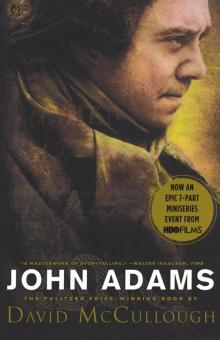 John Adams
John Adams The Greater Journey: Americans in Paris
The Greater Journey: Americans in Paris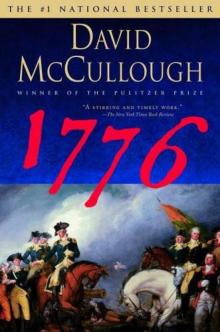 1776
1776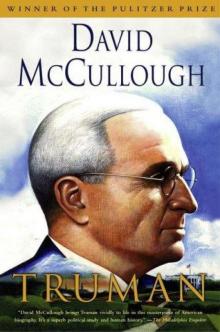 Truman
Truman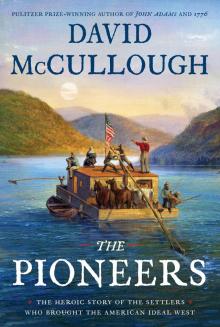 The Pioneers
The Pioneers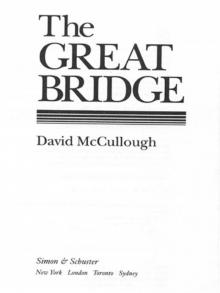 The Great Bridge: The Epic Story of the Building of the Brooklyn Bridge
The Great Bridge: The Epic Story of the Building of the Brooklyn Bridge The American Spirit
The American Spirit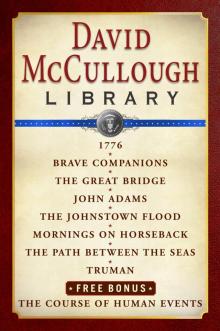 David McCullough Library E-book Box Set
David McCullough Library E-book Box Set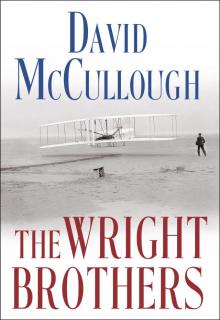 The Wright Brothers
The Wright Brothers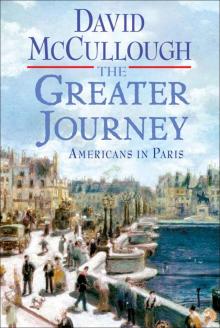 The Greater Journey
The Greater Journey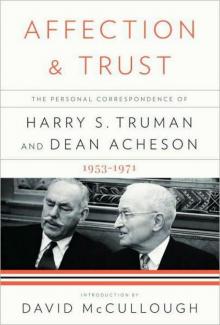 Affection and Trust: The Personal Correspondence of Harry S. Truman and Dean Acheson, 1953-1971
Affection and Trust: The Personal Correspondence of Harry S. Truman and Dean Acheson, 1953-1971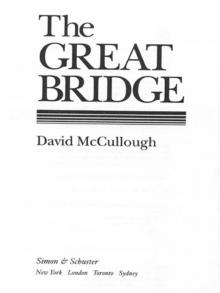 The Great Bridge
The Great Bridge